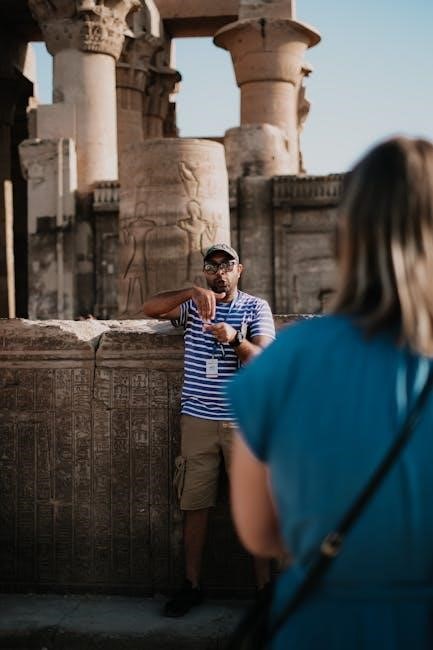Metairie Cemetery Self-Guided Tour: A Comprehensive Guide
Welcome to your adventure through Metairie Cemetery, a stunning “city of the dead” in New Orleans! This guide helps you explore its history, architecture, and the stories of notable figures at your own pace.
Embark on a self-guided journey through Metairie Cemetery, a National Register of Historic Places landmark. Explore the extravagant tombs of figures like Al Copeland, Ruth Fertel, and Anne Rice, set amidst almost 1,000 trees. Discover unique monuments, from Egyptian pyramids to Greek temples, reflecting New Orleans’ unique burial traditions. This comprehensive guide will help you uncover the stories etched in stone, offering a respectful and insightful exploration of this picturesque cemetery, often named among America’s Best Cemeteries by Forbes.

History and Establishment
Metairie Cemetery’s origins are rooted in the Reconstruction era, dating back to 1872. The site was formerly the Metairie Race Course, transforming from a place of sport to a city of the dead.
From Racetrack to Cemetery
Before its transformation into a serene and historically significant cemetery, Metairie was a bustling racetrack. The Metairie Race Course held a prominent place in New Orleans society. It was a popular venue for equestrian enthusiasts. However, after facing financial difficulties, the racetrack was repurposed. The principal owner of the Louisiana State Lottery acquired the land. He decided to convert it into a cemetery, marking a significant shift in the land’s purpose and character. This transition laid the foundation for the iconic Metairie Cemetery we know today.
The Vision of the Louisiana State Lottery Owner
After being denied membership to the Metairie Jockey Club, the principal owner of the Louisiana State Lottery harbored a vision. He vowed that the racetrack would one day become a cemetery. This vision became reality when he acquired the bankrupt Metairie Race Course in 1872. The owner transformed the grounds into a grand cemetery, showcasing elaborate tombs and funerary art. His ambitious endeavor turned a space of recreation into a peaceful city of the dead, leaving a lasting mark on New Orleans’ cultural landscape.
Notable Interments and Landmarks
Discover the final resting places of prominent figures and architectural marvels within Metairie Cemetery. Explore tombs of celebrities, unique monuments, and symbolic designs that make this cemetery a captivating historical landmark.
Millionaires’ Row: Tombs of the Famous
Step into Millionaires’ Row, where extravagant tombs tell the stories of New Orleans’ elite. Here lie the remains of industry titans, cultural icons, and influential figures who shaped the city’s landscape. Marvel at the opulent displays of wealth and artistic expression, reflecting the lives and legacies of those interred. Discover the history behind each monument, unveiling the tales of ambition, success, and enduring impact on New Orleans’ vibrant tapestry. From business magnates to celebrated artists, Millionaires’ Row offers a glimpse into the lives of the famous.
Al Copeland (Popeyes) and Ruth Fertel (Ruth’s Chris)
Pay homage to two culinary legends, Al Copeland, the founder of Popeyes Louisiana Kitchen, and Ruth Fertel, the visionary behind Ruth’s Chris Steak House. Their entrepreneurial spirit and dedication to flavor transformed the dining landscape. Explore their final resting places, reflecting on their remarkable journeys from humble beginnings to national acclaim. Witness the tributes to their culinary empires and the lasting impact they had on New Orleans’ food culture. Remember their contributions to the city’s gastronomic identity and the millions they delighted with their creations.
Anne Rice and Other Notable Figures
Discover the final resting place of Anne Rice, the celebrated author of gothic novels like “Interview with the Vampire,” among other prominent individuals. Her literary contributions brought New Orleans’ mystique to life for readers worldwide. Explore the monuments dedicated to local politicians, musicians like Louis Prima and Al Hirt, and influential figures who shaped the city’s vibrant culture. Reflect on their legacies and the impact they had on New Orleans’ history, arts, and entertainment scene. Uncover the stories behind these individuals who left indelible marks on the community.
Architectural Highlights and Symbolism
Metairie Cemetery showcases diverse architectural styles, blending Greek temples, Egyptian pyramids, and Celtic crosses. These structures reflect the cultural influences and beliefs of those interred. Symbolism abounds, from weeping angels representing grief to obelisks signifying eternity. The intricate details of the tombs offer insights into the lives and values of the deceased. Explore the unique designs and discover the hidden meanings behind the various symbols adorning the monuments, revealing a rich tapestry of history and artistic expression. Observe the elaborate marble tombs and funerary art throughout the cemetery.
Greek Temples, Egyptian Pyramids, and Celtic Crosses
Metairie Cemetery presents a fascinating fusion of architectural styles. Marvel at the Greek temples, reminiscent of ancient sanctuaries, symbolizing immortality and reverence. Discover the imposing Egyptian pyramids, guarded by sphinxes, representing power, mystery, and the afterlife. Admire the intricate Celtic crosses, blending Christian faith with ancient Celtic traditions, symbolizing eternal life and cultural heritage. This diverse collection reflects the varied backgrounds and beliefs of those buried within. Explore the juxtaposition of these iconic structures, creating a unique and awe-inspiring landscape. The blend offers a glimpse into diverse cultural influences.
Unique Tombs and Monuments
Beyond the grand architectural styles, Metairie Cemetery is adorned with unique tombs and monuments, each with its own story. Discover the poignant weeping angel statues, symbolizing grief and remembrance. Find the Christopher Columbus monument. Uncover symbolic offerings and elaborate sculptures that reflect personal stories, beliefs, and achievements. Explore the Islamic-inspired tomb built by a Confederate general for his daughter, a testament to love and cultural exchange. Notice the intricate details etched into marble and stone, revealing the artistry and craftsmanship of a bygone era. Each monument offers a glimpse into the past, reflecting the lives and legacies of those interred.
Planning Your Self-Guided Tour
Prepare for your Metairie Cemetery self-guided tour! Consider location, accessibility, tour duration, and what to bring. This planning ensures a comfortable and enriching experience while exploring this historic landmark.
Essential Information: Location and Accessibility
Metairie Cemetery, a National Register of Historic Places site, is located in New Orleans. The address is 5100 Pontchartrain Blvd. It is easily accessible by car, with ample parking available near the entrance. Wheelchairs and scooters are accommodated on the paved surfaces within the cemetery, ensuring accessibility for visitors with mobility concerns. Public transportation options also serve the area. Please note that there may be a minimum amount of guests signed up for the tour.
Tour Duration and Distance
A comprehensive self-guided tour of Metairie Cemetery typically takes around 1.5 to 2 hours to complete, allowing for ample time to explore the key landmarks and notable interments. The walking distance can vary depending on your chosen route, but it generally covers about a half mile to two miles across the paved pathways. It is a good idea to plan your route to see the extravagant tombs. Consider the time of day.
What to Bring: Comfort and Preparation
For a comfortable self-guided tour of Metairie Cemetery, it’s essential to come prepared. Wear comfortable walking shoes, as the tour involves walking on paved surfaces, as the cemetery is around two miles long. Bring water to stay hydrated, especially on warm days. Applying sunscreen is good. A hat or umbrella provides shade. A map or guidebook ensures you can navigate efficiently and locate specific tombs. Consider bringing a raincoat.

Navigating the Cemetery
Successfully navigate Metairie Cemetery by utilizing a map or guidebook to locate key sections and landmarks. Understanding the layout enhances your self-guided exploration of this historic and picturesque location.
Using a Map or Guidebook
Enhance your self-guided tour by acquiring a detailed map or guidebook of Metairie Cemetery. These resources provide invaluable assistance in locating specific tombs, notable interments, and architectural highlights. A map helps you navigate the sprawling grounds, ensuring you don’t miss key landmarks like Millionaires’ Row or the tombs of famous figures such as Al Copeland and Anne Rice. Guidebooks often include historical context, anecdotes, and symbolic interpretations, enriching your understanding and appreciation of this historic cemetery. They can also highlight unique monuments and the diverse architectural styles present, from Greek temples to Egyptian pyramids.
Key Sections and Landmarks to Visit
Prioritize visiting key sections within Metairie Cemetery to maximize your self-guided tour experience. Millionaires’ Row is a must-see, showcasing extravagant tombs of prominent figures like Al Copeland and Ruth Fertel. Seek out the resting places of Anne Rice and other notable New Orleanians. Admire the architectural diversity, noting the Greek temples, Egyptian pyramids, and Celtic crosses. Locate unique monuments such as the Islamic-inspired tomb built by a Confederate general. Consult your map to efficiently navigate between these highlights, ensuring a comprehensive exploration of the cemetery’s most significant landmarks and historical treasures during your visit.

Respectful Visitation
Remember to maintain decorum. Avoid loud noises and treat the cemetery with the respect it deserves. Stay on marked paths and refrain from touching or damaging any monuments or markers.
Cemetery Etiquette and Guidelines
When visiting Metairie Cemetery, it’s crucial to remember that this is a sacred and historical site. Maintain a respectful demeanor by speaking softly and avoiding disruptive behavior. Refrain from climbing on or touching the tombs and monuments, as these are fragile and irreplaceable. Dispose of any trash properly and stay on designated pathways to avoid damaging the landscape. Photography is generally permitted, but be mindful of others and avoid using flash photography inside mausoleums. Remember to honor the memory of those interred here by treating the cemetery with the utmost respect and care.
Preservation and Restoration Efforts
Metairie Cemetery’s historical significance necessitates ongoing preservation and restoration. Non-profit organizations like “Save Our Cemeteries” play a vital role in protecting these landmarks through fundraising and restoration projects. These efforts address issues like weathering, vandalism, and structural damage to tombs and monuments. Skilled artisans and preservationists work diligently to repair and stabilize these historic structures, ensuring their survival for future generations. Proceeds from tours often contribute to these efforts, allowing visitors to support the cemetery’s upkeep while learning about its rich history. You can contribute by donating or volunteering!

Tour Options and Alternatives
Explore Metairie Cemetery through various avenues. Choose guided tours for expert insights or embrace self-guided exploration for independent discovery. Consider options that align with your interests and preferred pace;
Guided Tours vs. Self-Guided Exploration
Consider the advantages of guided tours versus self-guided exploration at Metairie Cemetery. Guided tours provide in-depth historical context and captivating stories from knowledgeable guides, ensuring you don’t miss key landmarks. These tours often focus on notable interments and architectural highlights, offering a structured and informative experience.
Alternatively, self-guided tours allow for independent discovery and flexibility, enabling you to explore at your own pace and delve into areas of personal interest. With a map or guidebook, you can uncover hidden gems and create a personalized itinerary. The choice depends on your preferred learning style and desired level of interaction.
Save Our Cemeteries Tours
Enhance your Metairie Cemetery experience by joining a tour with Save Our Cemeteries. This non-profit organization offers historically accurate and insightful tours, contributing directly to the preservation and protection of New Orleans’ historic cemeteries. Their small group tours provide an intimate and engaging experience, revealing the unique burial traditions and the stories behind the elaborate tombs.
By participating in a Save Our Cemeteries tour, you not only gain a deeper understanding of Metairie Cemetery’s rich history but also support their vital restoration efforts, ensuring the enduring legacy of this cultural landmark for future generations. Check their schedule for availability.
Metairie Cemetery offers a unique blend of history, art, and culture. Its enduring appeal lies in its ability to connect us with the past and inspire reflection on life and legacy.
The Enduring Appeal of Metairie Cemetery
Metairie Cemetery’s enduring appeal stems from its rich tapestry of history, art, and cultural significance. It is more than just a burial ground; it’s a living museum showcasing stunning architecture, intricate sculptures, and poignant stories of New Orleans’ most influential figures. From the extravagant tombs of millionaires to the modest markers of everyday citizens, each site tells a tale of life, death, and legacy. This picturesque cemetery attracts visitors seeking to connect with the past and contemplate the human experience, ensuring its place as a must-see destination.
